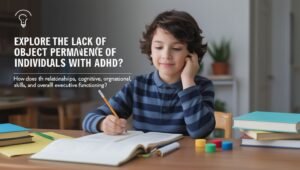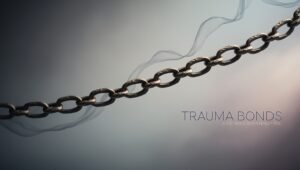Object permanence is a concept that many people associate with early childhood development, but its implications extend far beyond the toddler years. For adults with ADHD (Attention Deficit Hyperactivity Disorder), object permanence—or rather, the lack of it—can have a significant impact on daily life, relationships, and productivity. While many may be familiar with object permanence as it relates to infants, understanding how it plays out in adults with ADHD opens a door to deeper insight into the challenges they face. In this post, we’ll explore the nuances of object permanence, why it matters for people with ADHD, and how to deal with its effects.
What Is Object Permanence?
Object permanence is the understanding that objects continue to exist even when they are out of sight. This concept is typically developed in early childhood, around 8 to 12 months old, and is considered a key milestone in cognitive development. Babies who haven’t yet developed object permanence believe that when something is hidden from view—like a toy under a blanket—it ceases to exist. As they grow, they learn that the toy still exists, even when they can’t see it.
However, for adults with ADHD, the concept of object permanence can feel elusive, even though they intellectually understand that things don’t simply vanish when out of sight. This challenge extends beyond physical objects; it can also apply to tasks, responsibilities, and even people. In essence, if something isn’t immediately visible or present in their mind, it may be forgotten or neglected, leading to a variety of issues in day-to-day life.
A Close Look at ADHD Types
Before diving into how object permanence specifically impacts those with ADHD, it’s important to understand that ADHD isn’t a one-size-fits-all condition. As we discussed in previous posts, ADHD can present in various forms, each with different challenges.
- Classic ADHD involves both hyperactivity and inattention, where individuals struggle with staying focused and controlling impulses.
- Inattentive ADHD presents primarily as difficulty with focus and organization, without the hyperactive component.
- Over-focused ADHD includes a tendency to hyper-fixate on tasks or thoughts, often leading to difficulty switching between activities.
- Temporal Lobe ADHD, Limbic ADHD, and Ring of Fire ADHD each bring emotional and cognitive challenges that compound the difficulties associated with focus and attention.
- Anxious ADHD is marked by anxiety and heightened worry alongside classic ADHD symptoms.
No matter the type, individuals with ADHD often experience issues related to object permanence, contributing to difficulties with task management, personal relationships, and general productivity.
Why Does Object Permanence Matter for ADHD?
Object permanence is particularly important for people with ADHD because it plays into one of the core challenges of the condition: managing attention. When individuals with ADHD lose sight of an object or task, it can effectively “disappear” from their mental radar. This means they may forget about tasks they need to complete, misplace important items, or unintentionally neglect relationships and responsibilities.
For example, an adult with ADHD may leave their keys on the kitchen counter and, once they step out of the room, completely forget where they left them. This is more than simple forgetfulness; it’s an experience where the object no longer exists in their mental landscape because it’s out of sight. Similarly, a task or errand might feel incredibly urgent while it’s in front of them, but the moment they shift their focus, it fades from memory.
In relationships, this can manifest as someone with ADHD struggling to maintain contact with friends or family members. They may genuinely care about the person, but when they’re not interacting with them directly or consistently reminded, it can feel like the person drifts from their consciousness. This isn’t intentional neglect, but rather a challenge rooted in the brain’s difficulty with maintaining a mental representation of people and tasks that aren’t directly in front of them.
But Why Does It Happen?
The issue of object permanence in ADHD is deeply connected to how the ADHD brain processes attention and memory. People with ADHD often experience difficulties with working memory, which is the mental system that helps hold information temporarily while using it. Working memory allows us to keep track of ongoing tasks, stay organized, and remember where we left something.
In the ADHD brain, there’s often a struggle to maintain focus on tasks or items that aren’t immediately engaging. If something isn’t providing direct stimulation or isn’t urgently demanding attention, the brain may deprioritize it, making it easy for the person to forget it exists altogether. This lack of mental engagement results in the object permanence-like struggles that people with ADHD often face.
Object Permanence in ADHD vs. Autism
Object permanence issues are not exclusive to ADHD; individuals with Autism Spectrum Disorder (ASD) also experience challenges with object permanence, but the mechanisms behind it are slightly different.
In autism, issues with object permanence may be tied to difficulties in processing sensory information or managing the transitions between activities. For example, an individual with autism might struggle with object permanence because their brain processes visual and sensory information differently, making it difficult to maintain a mental image of an object or person when it’s not in front of them.
For people with ADHD, however, the challenge is more related to attention regulation and working memory deficits. While individuals with ADHD may intellectually understand that an object or task still exists, their brain doesn’t hold onto it long enough for them to act on that knowledge, leading to a cycle of forgetfulness and task neglect.
How Lack of Object Permanence Affects Daily Life for ADHD

The lack of object permanence in ADHD adults can affect nearly every aspect of daily life. Here are some common ways it plays out:
- Losing Things: Misplacing items is an everyday challenge for many adults with ADHD. Whether it’s car keys, wallets, or important paperwork, if something isn’t immediately visible, it can feel as though it’s been lost forever. This can lead to frustration and stress, particularly when time-sensitive or crucial items go missing.
- Forgetting Tasks: Tasks that aren’t immediately in front of someone with ADHD may be forgotten altogether. For example, if they are in the middle of washing dishes and someone calls, they may stop the task and forget to return to it, leaving unfinished chores throughout the day.
- Relationship Struggles: Object permanence also impacts relationships. For instance, an adult with ADHD may genuinely care about a friend but struggle to maintain regular contact because, once that person is out of sight or no longer immediately engaging, they may unintentionally forget to reach out.
- Difficulty with Long-Term Projects: ADHD adults often struggle to follow through with projects that require sustained focus over long periods. Once they step away from the task, it may fade from their mind, making it hard to pick back up where they left off.
Ways to Deal with ADHD Object Impermanence
While object permanence issues in ADHD can be challenging, there are strategies that can help individuals better manage their attention and memory:
- Visual Reminders: Keeping things visible is key. Use sticky notes, calendars, or apps to set reminders for important tasks. Placing items like keys or wallets in the same visible spot every day can also prevent them from being “lost.”
- External Cues: Set alarms or notifications on your phone for tasks that need to be done. Having an external system to track deadlines or appointments helps compensate for the brain’s difficulty in holding onto tasks that aren’t immediately in front of you.
- Routine Building: Developing strong routines helps to keep tasks from slipping through the cracks. By turning daily activities into habits, people with ADHD can mitigate the effects of object impermanence.
- Checklists: Using to-do lists for work tasks or household chores can keep things organized and visible, reducing the likelihood of forgetting important responsibilities.
- Accountability Partners: Having someone to check in with can provide an additional layer of accountability and support. Whether it’s a friend, family member, or coworker, having someone who reminds you of tasks can help compensate for memory lapses.
Peekaboo, I See You!
The phrase “Peekaboo, I see you!” might remind us of the classic game played with babies as they develop their sense of object permanence. For adults with ADHD, maintaining the presence of tasks, people, and objects in their mental space requires more than just a simple peekaboo game. However, by implementing strategies like visual reminders and external cues, it’s possible to overcome the challenges of object impermanence and regain control over daily life.
Healing from Trauma
While trauma can be deeply impactful, healing is possible with time, support, and proper treatment. Recovery from trauma often involves addressing both the emotional and physical symptoms. Some effective methods for healing include:
- Therapy: Trauma-focused therapy, such as Cognitive Behavioral Therapy (CBT) or Eye Movement Desensitization and Reprocessing (EMDR), can help individuals process their traumatic experiences and develop coping mechanisms.
- Mindfulness and Relaxation Techniques: Practices like meditation, deep breathing exercises, and yoga can help individuals reconnect with their bodies and reduce anxiety or hypervigilance.
- Support Networks: Having a strong support system of friends, family, or support groups can provide a safe space to share experiences, reduce feelings of isolation, and offer emotional support.
- Medication: In some cases, medications such as antidepressants or anti-anxiety medications may be prescribed to help manage the symptoms of trauma, particularly in individuals with PTSD or severe anxiety.
- Self-care: Engaging in self-care activities, maintaining a healthy routine, getting adequate rest, and setting boundaries can help a trauma survivor regain a sense of control and stability.
Conclusion
Object permanence plays a significant role in the daily lives of adults with ADHD. While it’s a concept typically associated with early childhood, its impact on ADHD adults is profound, affecting everything from task management to personal relationships. Understanding how ADHD and object permanence intersect allows individuals to take proactive steps in managing their attention, memory, and overall well-being. By using tools like reminders, routines, and accountability systems, ADHD adults can mitigate the effects of object impermanence and build a more organized, balanced life.











